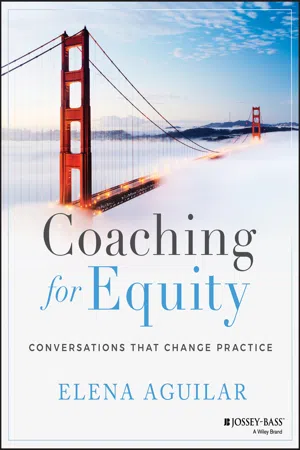
- English
- ePUB (mobile friendly)
- Available on iOS & Android
About this book
Your Guide to Creating Equitable Schools
If we hope to interrupt educational inequities and create schools in which every child thrives, we must open our hearts to purposeful conversation and hone our skills to make those conversations effective. With characteristic honesty and wisdom, Elena Aguilar inspires us to commit to transforming our classrooms, lays bare the hidden obstacles to equity, and helps us see how to overcome these obstacles, one conversation at a time.
Coaching for Equity is packed with the resources necessary to implement Transformational Coaching in any organization. In addition to an updated coaching framework and corresponding rubrics, a comprehensive set of coaching tools puts success in every coach's hands. Extensive personal narratives demonstrate what coaching for equity looks like and help us see how we can make every conversation count towards building a more just and equitable world.
Coaching for Equity covers critical topics in the larger conversation about racial equity, and helps readers develop the knowledge, dispositions and skills to be able to:
- Talk productively about race,
- Build trust to support vulnerability,
- Unpack mental models and change someone's mind,
- Observe classrooms and collect data to support equitable outcomes,
- Inspire others and deepen commitment,
- Evaluate and celebrate growth.
Perfect for teachers, teacher leaders, coaches and administrators, Coaching for Equity offers extensive strategies for talking about race, power, and systems of oppression. In framing the rationale for transformational conversations, Coaching for Equity gives us the context we need to enter into this work. In laying out the strategies, tools and models for critical conversations, it gives us the way forward.
Comprehensive, concrete, and deeply human, Coaching for Equity is the guide for those who choose to accept responsibility for interrupting inequities in schools. It is for all educators who know there is a better way.
Frequently asked questions
- Essential is ideal for learners and professionals who enjoy exploring a wide range of subjects. Access the Essential Library with 800,000+ trusted titles and best-sellers across business, personal growth, and the humanities. Includes unlimited reading time and Standard Read Aloud voice.
- Complete: Perfect for advanced learners and researchers needing full, unrestricted access. Unlock 1.4M+ books across hundreds of subjects, including academic and specialized titles. The Complete Plan also includes advanced features like Premium Read Aloud and Research Assistant.
Please note we cannot support devices running on iOS 13 and Android 7 or earlier. Learn more about using the app.
Information
CHAPTER 1
Transformational Coaching: A Model for Change
Structures to Span Chasms
Table of contents
- COVER
- TABLE OF CONTENTS
- ABOUT THE AUTHOR
- ACKNOWLEDGMENTS
- INTRODUCTION
- CHAPTER 1: Transformational Coaching: A Model for Change
- CHAPTER 2: Jumping into Coaching for Equity
- CHAPTER 3: How to Understand Race, Racism, and White Supremacy
- CHAPTER 4: How to Talk About Race
- CHAPTER 5: What You Need to Know about Adult Learners
- CHAPTER 6: How to Change Someone's Mind
- CHAPTER 7: What You Need to Know about Emotions
- CHAPTER 8: What You Need to Know about Identity
- CHAPTER 9: Surfacing Current Reality
- CHAPTER 10: Recognizing Impact
- CHAPTER 11: Exploring Emotions
- CHAPTER 12: Creating New Practices
- CONCLUSION Towards Liberty and Justice for All
- APPENDIX A: APPENDIX AThe Phases of Transformational CoachingThe Phases of Transformational Coaching
- APPENDIX B: APPENDIX BThe Equity RubricThe Equity Rubric
- APPENDIX C: APPENDIX CTransformational Coaching Rubric (TCR) 2.0*Transformational Coaching Rubric (TCR) 2.0*
- APPENDIX D: APPENDIX DAdvocating for Systems ChangeAdvocating for Systems Change
- APPENDIX E: APPENDIX EThe Core EmotionsThe Core Emotions
- APPENDIX F: APPENDIX FResources for Further LearningResources for Further Learning
- GLOSSARY
- REFERENCES
- INDEX
- END USER LICENSE AGREEMENT